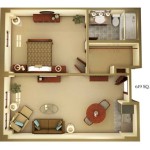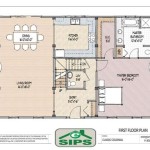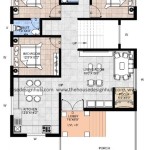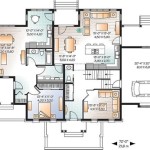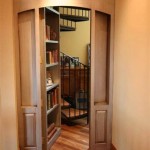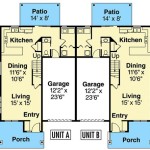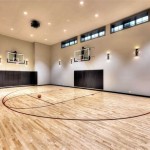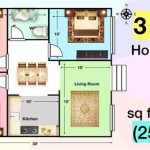House Plans for Cabins and Small Houses: Efficient Living in Compact Spaces
The appeal of cabins and small houses lies in their simplicity, affordability, and connection to nature. These dwelling options, often situated in serene locations, offer a respite from the complexities of modern life. Designing a cabin or small house, however, requires careful consideration of space utilization, functionality, and aesthetic appeal. Selecting the right house plan is paramount to achieving a comfortable and efficient living environment within a limited footprint. This article explores various aspects of house plans for cabins and small houses, highlighting key considerations and offering insights into designing and choosing the ideal layout for your needs.
House plans for cabins and small houses are distinct from those designed for larger residential properties. The emphasis is on maximizing every square foot of space, often incorporating multi-functional areas and clever storage solutions. The design process needs a thoughtful approach to ensure comfortable living with efficiency. This includes considering lighting, ventilation, and the flow of movement within the house. Ultimately, the goal is to create a space that feels larger than its actual dimensions, fostering a sense of openness and tranquility.
Prioritizing Functionality and Space Optimization
One of the most critical aspects of house plans for cabins and small houses is prioritizing functionality. Every room and area must serve a specific purpose and be designed to optimize space usage. This often involves integrating multiple functions into a single area, such as a living room that doubles as a guest bedroom or a kitchen island that serves as both a workspace and a dining area. The design should follow simple ideas of reducing unnecessary elements and focusing on essential features. This includes planning a seamless and smart layout that takes advantage of every corner and vertical space.
Open floor plans are a common feature in small house designs. These layouts eliminate interior walls, creating a more expansive and airy feel. This encourages movement and interaction and allows for more natural light to permeate the space. However, open floor plans require careful consideration of zoning and furniture placement to define different areas and maintain privacy. The implementation of appropriate furniture and interior design is vital in organizing the space to create distinct living zones.
Vertical space is a valuable asset in small house design. Lofts, high ceilings, and strategically placed shelving can significantly increase storage capacity and create a sense of spaciousness. Loft spaces can be used as bedrooms, offices, or reading nooks, adding extra living area without expanding the footprint of the house. Built-in storage solutions, such as wall-mounted cabinets, under-bed storage, and hidden compartments, are also essential for maximizing space and minimizing clutter. Furthermore, consideration should be given to adaptable furniture such as foldable tables and stackable chairs, which can be easily stored when not in use. These solutions help maintain an open and organized living environment.
Understanding Different Cabin and Small House Styles
The architectural style of a cabin or small house plan greatly impacts its overall aesthetic and functionality. Various styles cater to different preferences and geographical locations, each offering unique characteristics and advantages. Whether you envision a rustic log cabin nestled in the woods or a modern minimalist tiny house, understanding the different styles available is crucial for selecting the right house plan. The style adopted affects not only the external appearance but also the interior layout and the materials used in construction.
Log cabins evoke a traditional and rustic charm, often constructed from natural wood materials. These designs typically feature exposed log walls, a stone fireplace, and a cozy, intimate atmosphere. Log cabin house plans often incorporate large windows to maximize natural light and provide views of the surrounding landscape. While log cabins offer a timeless appeal, they require specialized construction techniques and may necessitate regular maintenance to prevent wood rot and insect infestation. Design of a log cabin should prioritize the conservation of heat and the reduction of drafts.
Modern small houses emphasize clean lines, minimalist decor, and energy efficiency. These designs often incorporate sustainable materials, such as recycled wood, solar panels, and rainwater harvesting systems. Modern small house plans typically feature open floor plans, large windows, and sleek, contemporary finishes. The focus is on creating a functional and aesthetically pleasing space that minimizes environmental impact. Modern styles often use innovative space-saving techniques to maximize the living area in a small footprint, while incorporating features like smart home technology to promote efficiency and convenience.
Cottage-style cabins and small houses exude a cozy and inviting atmosphere, characterized by charming details, such as pitched roofs, dormer windows, and wraparound porches. These designs often feature a mix of natural materials, such as wood, stone, and brick, creating a warm and welcoming ambiance. Cottage-style house plans typically include a comfortable living room, a functional kitchen, and small bedrooms. These designs often prioritize outdoor living space, incorporating features like gardens, patios, and decks to connect with the surrounding natural environment. The decorative elements often incorporate floral patterns, soft colors, and vintage furniture, enhancing the overall cozy and inviting feeling.
Exploring Essential Features and Considerations
Beyond the overall style and layout, several essential features and considerations influence the design and functionality of house plans for cabins and small houses. These elements range from insulation and ventilation to kitchen layout and bathroom design, and they play a vital role in creating a comfortable, efficient, and sustainable living environment. Understanding these aspects is important for making informed decisions and ensuring that the final product meets your specific needs and preferences. Careful planning of these details ensures that the house is both functional and comfortable throughout the year.
Proper insulation and ventilation are crucial for maintaining a comfortable indoor climate, especially in cabins and small houses. Effective insulation minimizes heat loss during the winter and heat gain during the summer, reducing energy consumption and lowering utility bills. Ventilation ensures adequate airflow, preventing moisture build-up and improving indoor air quality. Insulating materials include fiberglass, cellulose, and spray foam insulation, each offering varying levels of thermal resistance. Ventilation options include natural ventilation, such as windows and vents, and mechanical ventilation, such as fans and air exchangers. Combined strategies for insulation and ventilation contribute to a healthy and energy-efficient living environment.
Kitchen design in small houses requires careful planning to maximize efficiency and functionality. Compact kitchens often incorporate space-saving appliances, such as a combination microwave/oven, a small refrigerator, and a portable dishwasher. Open shelving, wall-mounted cabinets, and pull-out drawers can increase storage capacity and keep countertops clear. Furthermore, smart kitchen design promotes a smooth workflow and allows for easy access to essential items. Islands or peninsulas can provide additional workspace and seating. Proper lighting, including task lighting and ambient lighting, is essential for creating a functional and inviting kitchen space.
Bathroom design in small houses must prioritize functionality and space efficiency. Compact bathrooms often incorporate a shower stall instead of a bathtub to save space. Wall-mounted sinks and toilets can also free up floor space and create a more open feel. Storage solutions, such as recessed shelving, under-sink cabinets, and over-the-toilet storage units, are essential for maximizing space and minimizing clutter. Proper ventilation is crucial for preventing moisture build-up and mold growth. The choice of materials, such as light-colored tiles and reflective surfaces, can enhance the sense of spaciousness and brightness in a small bathroom.

Small Cabin Designs With Loft Floor Plans House Plan
:max_bytes(150000):strip_icc()/SL-731_FCP-83e310d6c4f4422a88bd36464339bf30.jpg?strip=all)
26 Tiny House Plans That Prove Bigger Isn T Always Better

10 Impressively Unique Cabin Floor Plans Adorable Living Spaces Rustic Small House

Small Cabin House Plans With Loft And Porch For Fall Houseplans Blog Com

Small Log Homes Kits Southland

Rustic Vacation Homes Simple Small Cabin Plans Houseplans Blog Com

Small Cabin Designs With Loft Floor Plans

Floor Plans For Tiny Houses Besting A Frames Cabins Sheds Unique Small House Build Your Own
:max_bytes(150000):strip_icc()/SL-988_FCR-0a1aa759de95445a96be45a8aefc2749.jpg?strip=all)
Cabins And Cottages Under 1 000 Square Feet

Small House Floor Plan The Plain Front Could Be Jazzed Up Considerably But It S A Livable Vacation Tiny Kits Plans

